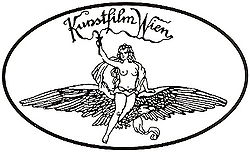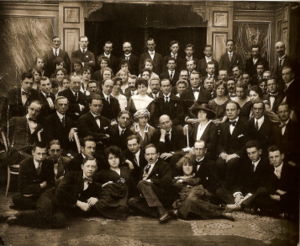
Wiener Kunstfilm
Encyclopedia

English language
English is a West Germanic language that arose in the Anglo-Saxon kingdoms of England and spread into what was to become south-east Scotland under the influence of the Anglian medieval kingdom of Northumbria...
: "Vienna Art Film Industry"), was the first major Austria
Austria
Austria , officially the Republic of Austria , is a landlocked country of roughly 8.4 million people in Central Europe. It is bordered by the Czech Republic and Germany to the north, Slovakia and Hungary to the east, Slovenia and Italy to the south, and Switzerland and Liechtenstein to the...
n film production company. Founded in 1910
1910 in film
The year 1910 in film involved some significant events.-Events:*The newsreel footage of the funeral of King Edward VII of the United Kingdom is shot in Kinemacolor, making it the first color newsreel....
as the Erste österreichische Kinofilms-Industrie, it was a pioneer in almost every field of silent film
Silent film
A silent film is a film with no synchronized recorded sound, especially with no spoken dialogue. In silent films for entertainment the dialogue is transmitted through muted gestures, pantomime and title cards...
in Austria.
History
Wiener Kunstfilm was founded in January 1910 as the Erste österreichische Kinofilms-Industrie in AlsergrundAlsergrund
Alsergrund is the ninth district of Vienna, Austria . It is located just north of the first, central district, Innere Stadt. Alsergrund was incorporated in 1862, with seven suburbs. The area is densely populated, with a lot of government-built housing. According to the census of 2001, there were...
in Vienna by the photographer Anton Kolm
Anton Kolm
Anton Kolm was an Austrian photographer who became one of the first film directors and film producers in the history of Austrian cinema....
, his wife Luise
Luise Fleck
Luise Fleck, also known as Luise Kolm or Luise Kolm-Fleck, née Louise or Luise Veltée , was an Austrian film director, and the second ever female film director in the world, after Alice Guy-Blaché...
née Veltée, daughter of the owner of a panopticon
Panopticon
The Panopticon is a type of building designed by English philosopher and social theorist Jeremy Bentham in the late eighteenth century. The concept of the design is to allow an observer to observe all inmates of an institution without them being able to tell whether or not they are being watched...
, and the cameraman Jacob Fleck
Jacob Fleck
Jacob Fleck was an Austrian film director, screenwriter, film producer and cameraman.-Biography:...
.
Wiener Kunstfilm was established at a time when the Austro-Hungarian cinema market was almost totally dominated by French
France
The French Republic , The French Republic , The French Republic , (commonly known as France , is a unitary semi-presidential republic in Western Europe with several overseas territories and islands located on other continents and in the Indian, Pacific, and Atlantic oceans. Metropolitan France...
companies. In order to be able to resist these financially powerful international companies, Wiener Kunstfilm, in its role as the first Austrian film production company, needed, and received, the full support of patriotic media and cinema proprietors.
The company is distinguished as the first in Austria to produce a weekly newsreel; it also produced the first Austrian drama film
Drama film
A drama film is a film genre that depends mostly on in-depth development of realistic characters dealing with emotional themes. Dramatic themes such as alcoholism, drug addiction, infidelity, moral dilemmas, racial prejudice, religious intolerance, poverty, class divisions, violence against women...
, as well as achieving a number of other Austrian cinematic firsts. Since during its first years it ceaselessly filmed important events, Wiener Kunstfilm also has great significance as the chronicler of the last glittering years of the Austro-Hungarian monarchy.
During World War I
World War I
World War I , which was predominantly called the World War or the Great War from its occurrence until 1939, and the First World War or World War I thereafter, was a major war centred in Europe that began on 28 July 1914 and lasted until 11 November 1918...
, although its former French rivals vanished from the picture, expelled from Austria as enemy aliens, Wiener Kunstfilm came under increasing pressure from the rival Austrian company Sascha-Film
Sascha-Film
Sascha-Film, in full Sascha-Filmindustrie AG and from 1933 Tobis-Sascha-Filmindustrie AG, was the largest Austrian film production company of the silent film and early sound film period.-History:...
, backed by the immense family wealth of its proprietor, Count Sascha Kolowrat-Krakowsky
Alexander Kolowrat
Count Alexander Joseph von Kolowrat-Krakowsky , better known as "Sascha", was an Austrian film producer of Bohemian descent...
, which by 1918 had secured dominance of the market. Wiener Kunstfilm was forced into liquidation in 1919, although refounded by Anton and Luise Kolm as the short-lived Vita-Film
Vita-Film
Vita-Film was founded in 1919 as the successor company to Wiener Kunstfilm-Industrie by Anton and Luise Kolm.By 1923 Vita-Film had built the Rosenhügel Film Studios in the Vienna suburbs, which still stand and are still used for film production...
.
Co-workers

Screenwriter
Screenwriters or scriptwriters or scenario writers are people who write/create the short or feature-length screenplays from which mass media such as films, television programs, Comics or video games are based.-Profession:...
.
Other directors who worked occasionally for Wiener Kunstfilm were Walter Friedemann, Ludwig Ganghofer
Ludwig Ganghofer
Ludwig Ganghofer was a German writer who became famous for his homeland novels.-Biography:Born in Kaufbeuren, he graduated from a gymnasium in 1873 and subsequently worked as a fitter in Augsburg engine works...
, Max Neufeld
Max Neufeld
Max Neufeld was an Austrian film director, actor and screenwriter. He directed 70 films between 1919 and 1957. He directed the 1934 film The Song of the Sun, which starred Vittorio De Sica.-Selected filmography:...
and Hans Otto Löwenstein.
Studio
The studio of Wiener Kunstfilm was apparently located in MauerMauer, Vienna
Mauer is a former village of Lower Austria that since 1938 has been part of Vienna. Today it is part of the 23rd District of Vienna, Liesing. Its name literally means "wall".- History :...
(now part of Vienna, then a village just outside the city boundaries), according to contemporary advertisements, presumably on the same site as the still-extant Rosenhügel Film Studios, which were built by the successor company, Vita-Film.
Productions
All productions of the period were silent and apart from major features were usually no more than 20 minutes in length, and this applied also to the productions of Wiener Kunstfilm. Several subjects were produced twice. The following list is a selection of their work, mostly dramas; only a very few of the enormous quantity of weekly news reels are noted.- Der Faschingszug in Ober-St. Veit ("The Fasching Procession in Ober-St. Veit"; newsreel, 1910)
- Der Trauerzug Sr. Exzellenz des Bürgermeisters Dr. Karl Lueger ("The Funeral Procession of His Excellency the Mayor Dr. Karl LuegerKarl LuegerKarl Lueger was an Austrian politician and mayor of Vienna. The populist and anti-Semitic politics of his Christian Social Party are sometimes viewed as a model for Hitler's Nazism.- Career :...
"; newsreel, 1910) - Die böse Schwiegermutter (1910)
- Die Ahnfrau (1910, 1919)
- Typen und Szenen aus dem Wiener Volksleben (documentary, 1911)
- Volkssänger (1911)
- Der Dorftrottel (1911)
- Die Glückspuppe (1911)
- Mutter - Tragödie eines Fabriksmädels (1911)
- Nur ein armer Knecht (1911)
- Martha mit dem Hosenrock (1911)
- Der Müller und sein KindDer Müller und sein KindDer Müller und sein Kind, a silent film made in 1911, is the oldest Austrian drama film to survive in its entirety. It was produced by the Österreichisch-Ungarische Kinoindustrie, which later in 1911 changed its name to become the Wiener Kunstfilm-Industrie...
(1910, 1911; premiere 21 October 1911) - Trilby (1912)
- Das Gänsehäufel (documentary, 1912)
- Karl Blasel als Zahnarzt (1912)
- Der Unbekannte (1912)
- Der Psychiater (second title Das Proletarierherz, 1913)
- Der Pfarrer von Kirchfeld (1913/1914; premiere 30 October 1914)
- Svengali (1914)
- Das vierte Gebot (1914)
- Der Meineidbauer (1915)
Sources
- Francesco Bono, Paolo Caneppele, Günter Krenn (eds.): Elektrische Schatten, Verlag Filmarchiv Austria, Vienna 1999, ISBN 3-901932-02-X
- Walter Fritz: Im Kino erlebe ich die Welt: 100 Jahre Kino und Film in Österreich. Verlag Christian Brandstätter, Vienna 1997, ISBN 3854476612.

